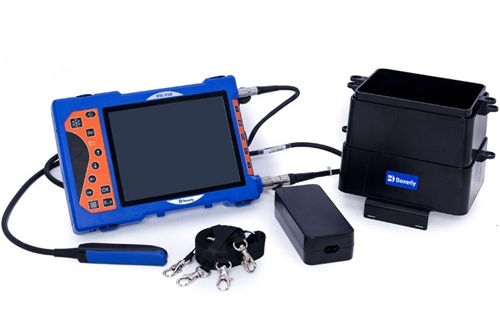For breeders of elite racehorses, every pregnancy is a high-stakes investment. The genetic potential of both stallion and mare, the considerable costs of breeding, and the long wait for a live foal with racing promise all converge into a process where precision is everything. In this landscape, ultrasound pregnancy tools have revolutionized breeding programs by providing real-time, accurate, and non-invasive assessments of reproductive status. En este artículo, I’ll explore how ultrasound is used to improve breeding accuracy in high-value racehorses, how it supports decision-making at every stage of reproduction, and why this technology has become indispensable to modern equine reproduction management.

The Unique Challenges of Breeding High-Value Racehorses
Breeding Thoroughbreds and other high-performance racehorses differs significantly from breeding ordinary livestock. Each mating decision may involve stallions whose stud fees reach hundreds of thousands of dollars, combined with mares valued in the millions. The stakes are high not only financially but also genetically, with breeders aiming to combine specific bloodlines, conformations, and performance traits to produce the next generation of champions.
In such a sensitive context, failure to achieve pregnancy, loss of pregnancy, or undiagnosed reproductive abnormalities can have devastating economic and emotional consequences. Historically, visual observation and manual palpation were the primary methods to confirm pregnancy or diagnose reproductive problems. While useful, these methods have limitations in sensitivity, accuracy, and timing—particularly in the earliest stages of pregnancy when intervention might still be possible.
This is where ultrasound pregnancy tools provide a crucial advantage.
Ultrasound in Early Pregnancy Diagnosis
Ultrasound technology allows veterinarians to detect pregnancy in mares as early as 11 Para 14 days post-ovulation. In high-value racehorse breeding programs, this early confirmation is invaluable for several reasons:
-
Timely rebreeding: If pregnancy has not been achieved, the mare can be returned to estrus and bred again within the same season, maximizing her chances of producing a foal that year.
-
Multiple pregnancy management: Twin pregnancies are undesirable and often dangerous in horses, as they frequently result in spontaneous abortion or the birth of weak foals. Ultrasound allows early identification of twin embryos, enabling veterinarians to perform manual embryo reduction (known as “pinching”) to increase the likelihood of a healthy singleton pregnancy.
-
Monitoring embryonic development: Early ultrasound can detect abnormal development or non-viable pregnancies that may not be outwardly apparent.
Unlike manual palpation, which relies heavily on the practitioner’s experience and can vary in accuracy, ultrasound provides visual confirmation. The B-mode (brightness mode) real-time imaging allows practitioners to view the uterus and developing embryo with clarity, identifying the embryonic vesicle, heartbeat, and uterine tone.

Reproductive Monitoring Throughout Gestation
While early pregnancy confirmation is critical, ultrasound’s role extends far beyond the initial weeks. Throughout gestation, periodic ultrasound examinations provide valuable insights that influence management decisions, Incluido:
-
Fetal viability checks: Identifying signs of fetal distress or non-viability allows for timely intervention, treatment, or in some cases, humane management decisions.
-
Placental evaluation: Ultrasound can detect placentitis (inflammation or infection of the placenta), which is a significant cause of late-term abortion in mares.
-
Cervical length and uterine tone monitoring: These parameters help assess the mare’s readiness for foaling and identify potential issues like premature placental separation.
In high-value racehorses, where every foal represents years of planning and considerable financial investment, this level of monitoring provides peace of mind and actionable data to veterinarians and breeders alike.
Ultrasound-Guided Breeding: Ovulation Timing and Artificial Insemination
Beyond pregnancy diagnosis, ultrasound also plays a vital role in improving conception rates by precisely timing breeding efforts. Mares’ ovulation windows are often narrow, and breeding too early or too late can reduce the chance of successful fertilization.
Using transrectal ultrasound, veterinarians can visualize:
-
Follicle size and development: The growing dominant follicle can be measured accurately, indicating when ovulation is imminent.
-
Uterine edema patterns: These changes signal optimal timing for breeding.
-
Corpus luteum formation: Post-ovulation assessments confirm successful ovulation.
Para artificial insemination (AI) programs, particularly with frozen semen—which has a short viable window—ultrasound-guided breeding ensures semen is introduced precisely when the mare is most fertile. This precision significantly increases conception rates and reduces the number of costly insemination attempts.

Ultrasound in Stallion Reproductive Evaluation
While much focus is placed on the mare, ultrasound also assists in evaluating stallion fertility. Ultrasonography can assess:
-
Testicular size, structure, and symmetry: Abnormalities such as tumors, fibrosis, or inflammation are detectable with ultrasound.
-
Accessory sex glands: Conditions affecting these glands can impair semen quality.
-
Scrotal abnormalities: Detection of hernias, hydroceles, or hematoceles provides critical information about breeding soundness.
By thoroughly evaluating both the mare and stallion with ultrasound, breeders can optimize pairing strategies and address reproductive issues before significant financial investments are made.
Why Ultrasound? The Core Benefits for High-Value Racehorse Breeding
From the perspective of racehorse breeders and veterinarians, the benefits of ultrasound technology are clear and multifaceted:
-
Non-invasive and safe: Ultrasound causes no harm or stress to the animal, making it ideal for frequent monitoring.
-
Real-time imaging: Immediate visualization allows rapid decision-making.
-
High accuracy: Particularly when performed by experienced veterinary practitioners, ultrasound offers superior diagnostic accuracy compared to manual methods alone.
-
Early detection of problems: Whether detecting twins, placental issues, or poor uterine tone, early intervention can prevent pregnancy losses.
-
Optimized breeding schedules: Precise timing of breeding increases the likelihood of successful conception, reducing wasted cycles.
Practical Considerations in Implementing Ultrasound Technology
The effectiveness of ultrasound in racehorse breeding is not solely dependent on the technology itself but also on the skill and experience of the operator. High-quality portable ultrasound devices such as the BXL-V50 offer excellent image resolution, portability for field use, and long battery life—critical features for busy breeding farms. Yet, proper training remains essential.
Leading breeding centers often employ full-time reproductive veterinarians or collaborate with specialists who are adept at interpreting ultrasound images. These professionals undergo continuous education, staying updated on the latest techniques and reproductive protocols.
Adicionalmente, careful scheduling is necessary. Early scans typically occur 11-14 days post-ovulation, with follow-up scans scheduled at key developmental milestones (p ej., 25 Días, 45 Días, and periodically throughout gestation). This structured approach ensures ongoing fetal health and allows prompt intervention when abnormalities are detected.

Case Study: A Breeder’s Experience with Ultrasound Monitoring
At Lexington Thoroughbred Farm in Kentucky—one of the most renowned centers for racehorse breeding—ultrasound has become a core pillar of reproductive management. As farm manager Richard Morrison explains:
“We used to rely on palpation and observation, but since implementing comprehensive ultrasound protocols, our pregnancy retention rates have improved, and we’ve been able to prevent losses we may not have even detected before. Identifying twins early and monitoring placental health throughout gestation has been a game-changer. It’s simply too risky to leave things to chance when each foal represents such a significant investment.”
Morrison’s experience echoes what many elite breeders now consider standard practice: ultrasound is no longer an optional luxury but a fundamental requirement for modern racehorse breeding.
Limitations and Ethical Considerations
Despite its many advantages, ultrasound does have limitations. Early detection of pregnancy loss does not always allow for prevention; some losses are unavoidable due to genetic defects or uncontrollable factors. Over-reliance on technology can also lead to unnecessary interventions or stress if not managed carefully.
Furthermore, ethical considerations must guide interventions such as twin reduction, balancing the welfare of the mare with economic interests. Reputable breeding operations follow strict veterinary guidelines to ensure that reproductive management prioritizes animal welfare alongside commercial success.
Future Directions: Emerging Technologies Enhancing Ultrasound Applications
The field of equine reproductive ultrasonography continues to evolve. New developments include:
-
3D ultrasound imagenológico: Providing more detailed assessments of uterine and placental structure.
-
Elastografía: Assessing tissue stiffness to identify early placental or cervical dysfunction.
-
Integration with reproductive hormone assays: Combining real-time ultrasound imaging with progesterone and estrogen monitoring allows even more precise reproductive management.
As these technologies mature, breeders will have even greater tools to maximize reproductive success while enhancing animal welfare and reducing risk.
Conclusión
In the high-stakes world of elite racehorse breeding, precisión, timing, and accurate information are critical to success. Ultrasound pregnancy tools have transformed reproductive management by allowing early detection of pregnancies, identification of potential problems, and real-time monitoring throughout gestation. For both mares and stallions, ultrasound provides invaluable insights that help breeders make informed decisions, protect their investment, and increase the chances of producing healthy, competitive foals.
As technology continues to advance, and with devices like the BXL-V50 offering portability, high-definition imaging, and real-time feedback, ultrasound will remain at the heart of successful equine reproductive programs. With proper training, ethical oversight, and careful application, it provides breeders with both confidence and clarity in one of the most delicate and crucial aspects of the thoroughbred industry.
Reference Sources:
-
McKinnon, A.O., & Squires, E.L. (2011). Equine Reproduction. Wiley-Blackwell.
-
Samper, J.C. (2020). Practical Guide to Equine Reproduction. Elsevier.
-
American Association of Equine Practitioners (AAEP). (2023). Reproductive Ultrasonography in Mares. https://aaep.org/reproductive-ultrasonography
-
Ginther, O.J. (2014). Ultrasonic Imaging and Animal Reproduction: Caballos. Equiservices Publishing.
-
Kentucky Thoroughbred Farm Directory (2024). https://www.kentuckybred.org
